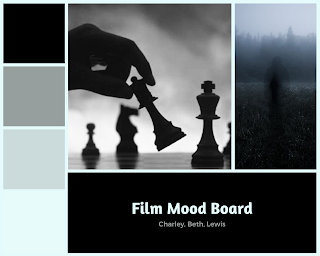Comparison Essay
‘The director is always the most important influence on a film'. Compare how far your two chosen films support this statement.
Both ‘Blade Runner’ and ‘The Lady From Shanghai’ are films from directors who are labelled as auteurs, which is defined as a sole creator of a film, that uses their personal style an ideas to make their films unique to them. Evidence of Ridley Scott and Orson Welles being auteurs comes from their signature styles, because this makes an auteur identifiable. When it comes to their films, an example of Scott’s style from ‘Blade Runner’ could be the “Tears in a rain” monologue, this is because of its use of rain, which is prevalent in many of Scott’s movies due to his English upbringing, the scene also uses smoke which makes an appearance in multiple of his films, then there’s the actors being shot with lowkey lighting, and the elaborate set designs of the buildings and the neon sign making the world feel real and it also shows Scott’s love for aesthetics. Similarly, scene which highlight’s Welles’ style in ‘The Lady From Shanghai’ is when Elsa and Michael are talking in the aquarium. In this scene the characters stand and walk in front of fish tanks with distorted and large creatures swimming inside this allows Welles’ to make use of his usual technique of deep focus which lets the audience look at the background and foreground of the shot. When in front of the tanks, the characters are silhouetted, as they are backlight by the light from the fishing tanks. As they move the camera tracks with them, which is one of Welles’ styles, as he is known as the master of the moving camera. On top of style, the movie is the director’s vision and ideas, which makes their influence the most important. Many of Ridley Scott’s films had overlapping themes which came from his own personal life such as stong female characters that mimic his views on his mother, and his estranged relationship to his father has led to multiple characters killing their fathers – both of these are present in ‘Blade Runner’ with Pris as the strong woman killing a replicant attacking Deckard and Roy Batty killing his creator Tyrell. Some themes are specific to ‘Blade Runner’ because of modern events in Scott’s life, one of which was the death of his older brother, Frank, which was what made him decide to make ‘Blade Runner’. Alternatively, ‘The Lady From Shanghai’ is a movie which mocks the classic noir conventions of a dumb protagonist and a femme fatale, which one could view to be a reflection of how Welles had a dislike for “safe movies” that “Hollywood producers like to make” for mass audiences to watch.
However, both of these movies were edited by the studio without the directors, which made the final product diluted – Welles was intended to have a hand in editing but in desperation to try and fix the plot editing was handed over to Viola Lawrence. Examples of changes would be how the original lengths of both the movies were cut short with ‘Blade Runner’ going from four hours long to two hours, and ‘The Lady From Shanghai’ going from one hundred and fifty five minutes to ninety two minutes. Not only did the studio cut many scenes from the films, they also added more too, for example with ‘Blade Runner’ Warner Bros added voice over to help the wider audience understand what was going on, then with ‘The Lady From Shanghai’ Harry Cohn forced Welles to include more close ups of Rita Hayworth for people to admire her beauty. This has led to people estimating that 75% of ‘The Lady From Shanghai’ was Welles’ own work, meaning 25% was the studio’s intervention. This would mean that while the director’s influence is important, in the end the studio has final say on what happens to the movie rather than the director, and so they can still remove the directors from the film, which was the case with Scott and Welles being fired from the movie. There is also the fact that making a film is a collaborative process, due to the fact that it takes more than one person to make a film, and by saying a director is the most important role, you would be diminishing the roles of the rest of the crew, which is unfair to the work that each person puts into the film. A film couldn’t exist without a director, but it also couldn’t exist without actors or editors, so therefore each role is necessary for a film to be made. The ideas of auteurs have been debated on whether they’re real or not, since a film is made by many people, and because of contributions not from the director, like how Roy Batty’s “Tears in the rain” monologue was written by the actor rather than the writer or director, which the director may have chosen to keep, but it wasn’t Scott’s original idea.
In conclusion, I believe that every role has its own importance when it comes to the movie’s creation, and that the director’s is just the one that most of the general public pay attention to (as well as the actors that play the characters). There isn’t a way to quantify how important someone’s role is, because without each role, the movie wouldn’t have happened the way it did. On top of that, making the film isn’t the final step of a film’s success, the movie still has to be marketed and shown to the public, which includes posters, trailers, getting cinemas to have showings. While ‘Blade Runner’ and ‘The Lady From Shanghai’ may have their director’s styles embedded into them, they both also have the studio’s changes too.


Comments
Post a Comment